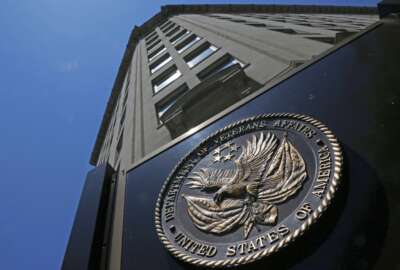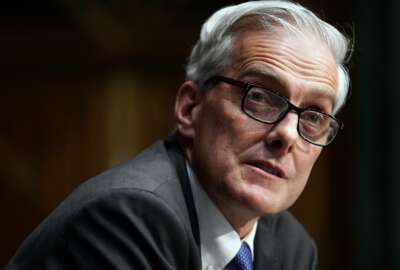VA sees more patients, cuts wait times, despite higher workload
The Department of Veterans is driving down wait times for veterans to receive health care — even as the VA sees record demand for its services.
The Department of Veterans Affairs is driving down wait times for veterans to receive health care — even as the VA sees record demand for its services.
The Veterans Health Administration in April saw an 11% decrease in average wait times for new patients in VA primary care, as well as a 7% decrease in average mental health care wait times, compared to last year.
VA set new records for medical appointments completed last year, but is on pace to break that record again this year.
The department, so far this year, completed 11% more patient appointments, compared to the same period last year — including 13% more mental health appointments for new patients.
Under Secretary for Health Shereef Elnahal told reporters Friday that these improved metrics come at a time when VA is delivering more care and more benefits to veterans than ever before.
“We’ve been able to meet that increasing demand for care, all while we’re seeing greater demand from our existing base of veterans, as they get older and get more chronic conditions and need more care,” Elnahal said.
The VA is providing historic levels of health care and benefits to veterans under the 2022 PACT Act, which expands eligibility for veterans exposed to toxic substances during their military service.
The department has enrolled more than 400,000 veterans in VA health care over the past year — a 30% increase compared to the year prior.
The average wait time to schedule a mental health appointment with the VA is about 17 days — meeting its access standard of 20 days or less.
Any veteran who must wait more than 20 days to schedule an appointment receives a referral to seek mental health care through non-VA community care.
“We’re really proud of our mental health access picture. I challenge any other health care system, frankly, to see what their wait times are compared to this,” Elnahal said.
VA stands at an average of 22 days for primary care appointments, falling slightly short of its 20-day access standard.
“We’re continuing to drive toward average wait times and experiences that fall within our access standards,” Elnahal said.
Recent department data shows nearly 92% of veterans who get health care from the VA trust the care they receive.
VA is also sustaining growth in appointments and a decrease in wait times, despite constrained hiring.
VHA hired more than 61,000 employees in fiscal 2023, its fastest rate of growth in 15 years, well exceeding its hiring goals. Efforts to boost retention also led to a 20% decrease in staff turnover between 2022 and 2023.
In response, VHA is limiting its hiring this year to a few key areas. VHA expects to reduce its headcount to just over 380,000 by the end of fiscal 2025 — compared to a recent peak of more than 400,000 employees. It expects to manage this workforce reduction through attrition.
“We’ve had to have a more constrained hiring posture now for several months. That is directly related to, ultimately, what the budget can support in total FTE count,” Elnahal said. “But even in the face of that more constrained hiring picture, we’ve seen sustained results on access.”
Elnahal said VHA is making more appointments available and decreasing wait times, which builds on momentum from “access sprints” that ran from October 2023 to February 2024.
Those sprints focused on offering night and weekend clinics, and by increasing the number of veterans each VA provider sees for appointments.
As part of those sprints, more than 80% of VA medical centers also saw more patients than they did a year ago.
“The good news is we’re seeing those results sustained. Much of that increased access, many of the new appointment slots that we’ve been able to offer have continued. And so, we’re not slowing down. We’re actually continuing the excellent results of the sprints,” Elnahal said.
The VA this week also announced the winners of its AI Tech Sprint. The department named 25 finalists for projects focused on reducing clinician burnout.
The AI tools include “ambient dictation,” or AI-powered note-taking that would take place during and after a veteran’s appointment with a VA clinician.
The VA also recognized AI tools that can automatically summarize hundreds of pages of outside medical records anytime a veteran comes into a VA clinic for the first time.
Elnahal said these projects include VA’s first investments in generative AI technology.
“All of these things are meant to eliminate rote tasks for clinicians and allow that clinician to spend more and more face time with veterans — and to do what they love, which is practice medicine and serve those who have served us,” Elnahal said.
Meanwhile, the House VA Committee is calling on Elnahal and other VA leaders to testify in a hearing next month on how the department awarded nearly $11 million in bonuses to more than 180 ineligible career executives.
The VA inspector general’s office recently found breakdowns in communications — and leadership — led to the bonuses being paid out last year.
More than 80% of the improperly paid bonuses went to members of the Senior Executive Service at VHA.
“There were issues that were missed at every layer of the organization. And of course, I take responsibility for everything that happens in VHA,” Elnahal said. “The most important thing we are doing is focusing on implementing the recommendations of the IG to make sure that this never happens again.”
Elnahal said over 90% of critical skills incentives have gone to eligible frontline employees — including police officers, housekeepers and food service workers.
“We have every indication that those were executed well, and with congressional intent,” he added.
Copyright © 2025 Federal News Network. All rights reserved. This website is not intended for users located within the European Economic Area.
Jory Heckman is a reporter at Federal News Network covering U.S. Postal Service, IRS, big data and technology issues.
Follow @jheckmanWFED






